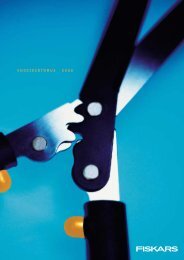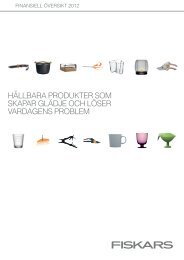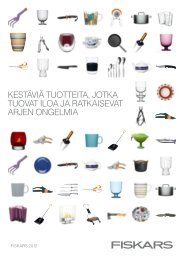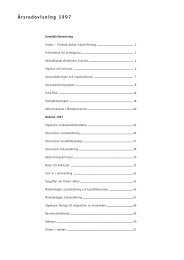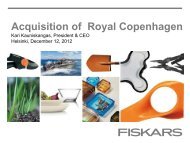FISKARS 1649 â 360 years of Finnish industrial history
FISKARS 1649 â 360 years of Finnish industrial history
FISKARS 1649 â 360 years of Finnish industrial history
You also want an ePaper? Increase the reach of your titles
YUMPU automatically turns print PDFs into web optimized ePapers that Google loves.
Fiskars <strong>1649</strong><br />
Fiskars <strong>1649</strong><br />
Stockholm in the 1690s. Sweden remained the most important producer <strong>of</strong> iron in Europe way into the 18th century.<br />
simple bar-iron shop at Mustio in Karjaa, which<br />
used the ore from the Ojamo mine. Mustio is thus<br />
considered to be Finland’s first ironworks.<br />
The term ironworks referred to <strong>industrial</strong><br />
establishments that had received <strong>of</strong>ficial permits<br />
(privilegio), such as pig-iron works, blast furnaces<br />
and other installations which concentrated mainly<br />
on refining iron ore and processing iron.<br />
Pohja becomes the cradle <strong>of</strong> the <strong>Finnish</strong> iron<br />
industry<br />
Sweden-Finland became a great power during the<br />
reign <strong>of</strong> Gustavus II Adolphus (1611–1623), but<br />
Sweden’s involvement in the Thirty Years’ War,<br />
which ended in the Peace <strong>of</strong> Westphalia in 1648,<br />
took heavy toll <strong>of</strong> the country’s resources. Efforts<br />
were made to raise living conditions in Finland<br />
to the standard in the mother country, Sweden.<br />
Governor General Per Brahe founded Finland’s first<br />
university in Turku in 1640. Sweden’s mercantilist<br />
policy restricted economic development, however,<br />
since all foreign trade was channelled through<br />
Stockholm. But mercantilism also favoured mining<br />
and the metal industry, as these were expected to<br />
increase the nation’s prosperity.<br />
In the 17th century, Sweden was a major<br />
European iron producer. Systematic ore prospecting<br />
also began in Finland in the 17th century, following<br />
a visit by King Gustavus II Adolphus. The first step<br />
was the reopening <strong>of</strong> the Ojamo mine in 1619. Until<br />
that point, all ironworks had been founded by the<br />
Crown, but now private merchants also became<br />
interested in the iron trade. Mining the ore in<br />
Finland soon proved unpr<strong>of</strong>itable, however, so iron<br />
ore began to be transported from Sweden, mainly<br />
from the Utö mine in the Stockholm archipelago.<br />
Pig iron was also shipped from Sweden for forging.<br />
The King favoured the transportation <strong>of</strong> iron ore<br />
and crude iron to Finland for processing because<br />
Signing the peace treaty <strong>of</strong> Westphalia, which in 1648 ended the Thirty Years’ War.<br />
he did not want to lay waste the Crown forests in<br />
Bergslagen.<br />
It was considered viable to found ironworks<br />
in Finland, although a high price had to be paid<br />
for the Swedish ore. There was an abundance <strong>of</strong><br />
unharnessed water power and above all vast forest<br />
resources for charcoal production. The ironworks<br />
had to be located close to a good harbour. The area<br />
around the parish <strong>of</strong> Pohja was densely forested and<br />
had rapids for water power as well as a suitable site<br />
for a harbour at Pohjankuru. Pohja thus became<br />
the centre <strong>of</strong> the <strong>Finnish</strong> iron industry. Ironworks<br />
were founded in Antskog around 1630, in Billnäs in<br />
1641 and in Fiskars in <strong>1649</strong>. Another two ironworks<br />
were built close to the parish <strong>of</strong> Pohja: in Mustio in<br />
1616 and in Fagervik in 1646.<br />
8<br />
9



